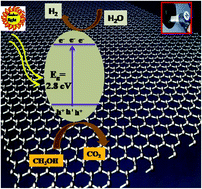Efficient solar light-driven hydrogen generation using an Sn3O4 nanoflake/graphene nanoheterostructure†
Abstract
Herein, we report Sn3O4 and Sn3O4 nanoflake/graphene for photocatalytic hydrogen generation from H2O and H2S under natural “sunlight” irradiation. The Sn3O4/graphene composites were prepared by a simple hydrothermal method at relatively low temperatures (150 °C). The incorporation of graphene in Sn3O4 exhibits remarkable improvement in solar light absorption, with improved photoinduced charge separation due to formation of the heterostructure. The highest photocatalytic hydrogen production rate for the Sn3O4/graphene nanoheterostructure was observed as 4687 μmol h−1 g−1 from H2O and 7887 μmol h−1 g−1 from H2S under natural sunlight. The observed hydrogen evolution is much higher than that for pure Sn3O4 (5.7 times that from H2O, and 2.2 times from H2S). The improved photocatalytic activity is due to the presence of graphene, which acts as an electron collector and transporter in the heterostructure. More significantly, the Sn3O4 nanoflakes are uniformly and parallel grown on the graphene surface, which accelerates the fast transport of electrons due to the short diffusion distance. Such a unique morphology for the Sn3O4 along with the graphene provides more adsorption sites, which are effective for photocatalytic reactions under solar light. This work suggests an effective strategy towards designing the surfaces of various oxides with graphene nanoheterostructures for high performance of energy-conversion devices.



 Please wait while we load your content...
Please wait while we load your content...